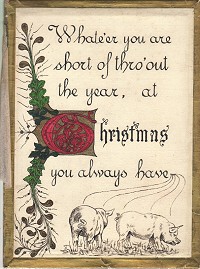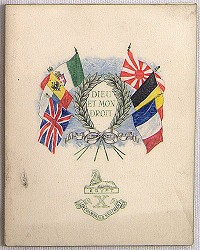Early Christmas Cards

Card with pigs!

Regimental Christmas card
Much like other Christmas traditions, Christmas cards were an early Victorian invention. The first commercial card appeared during December 1843 after Henry Cole, first director of the Victoria and Albert Museum, commissioned John Calcott Horsley to draw one and sold it for a shilling. However, it wasn’t until the 1860s that Christmas Cards became popular, particularly those in a postcard format that could be sent through the new ‘penny post.’ They were also helped by the new printing presses that combined colour, inks, fabrique applique and die cutting, thus making it a much simpler and cheaper process to make them.
Christmas cards were not like you see today. An example of this in the museum is one from circa 1935 that states ‘whate’er you are short of thro’out the year, at Christmas you always have’ and a picture of two pigs. The image of the pigs is representative of the traditional fattening up of a pig for Christmas, something which was commonplace until the middle of the twentieth century. The wording also indicates that, unlike today, big meals and plentiful food were not regular occurrences.
Another Christmas card, this time from 1915, was sent by Henry N Faulkner of the Lincolnshire Regiment. Their emblem was the Egyptian sphinx and has the flags of six countries, including Great Britain and France. In the centre is written ‘Dieu et mon droit’ (God and my right hand). As this was during world war one, and with Egypt being of strategic importance, particularly for the war in Africa, this card carries a lot of political weight. I think that this indicates the importance that Christmas cards had during this period, especially in a time before technology enabled communication.
Do you send Christmas cards? And if so what do they mean to you?